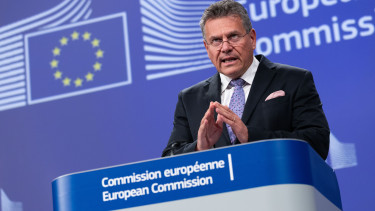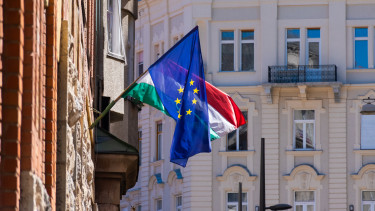Hungary installs backdoors in 2050 climate neutrality pledge

Man on the moon moment
The new European Commission has announced a Green Deal policy package to tackle climate change.
Today is the start of a journey. But this is Europe’s man on the moon moment
, EC President Ursula Von der Leyen told journalists before taking her climate pitch to the European Parliament, Reuters reported on Wednesday.
Von der Leyen said the Commission wants to mobilize 100 billion euros worth of investment to help the bloc’s economies pay for transition away from fossil fuels. To make the rest of the world follow suit, there would be a carbon border tax, essentially tariffs on imported polluting goods.
The European Green Deal resets the Commission’s commitment to tackling climate and environmental-related challenges that is this generation’s defining task.
"It is a new growth strategy that aims to transform the EU into a fair and prosperous society, with a modern, resource-efficient and competitive economy where there are no net emissions of greenhouse gases in 2050 and where economic growth is decoupled from resource use."
The figure below illustrates the various elements of the Green Deal.

The European Green Deal covers all sectors of the economy, notably transport, energy, agriculture, buildings, and industries such as steel, cement, ICT, textiles and chemicals.
Key data and proposals:
- The Commission has already set out a clear vision of how to achieve climate neutrality by 2050. TheCommission will propose the first European ‘Climate Law’ by March 2020.
- Between 1990 and 2018, it reduced greenhouse gas emissions by 23%, while the economy grew by 61%. However, current policies will only reduce greenhouse gas emissions by 60% by 2050. Much remains to be done, starting with more ambitious climate action in the coming decade.
- By summer 2020, the Commission will present an impact assessed plan to increase the EU’s greenhouse gas emission reductions target for 2030 to at least 50% and towards 55% compared with 1990 levels in a responsible way.
- These policy reforms will help to ensure effective carbon pricing throughout the economy. This will encourage changes in consumer and business behaviour, and facilitate an increase in sustainable public and private investment.
- The Commission will propose a carbon border adjustment mechanism, for selected sectors, to reduce the risk of carbon leakage. This would ensure that the price of imports reflect more accurately their carbon content.
- Further decarbonising the energy system is critical to reach climate objectives in 2030 and 2050. The production and use of energy across economic sectors account for more than 75% of the EU’s greenhouse gas emissions. Energy efficiency must be prioritised.
- To achieve the ambition set by the European Green Deal, there are significant investment needs. The Commission has estimated that achieving the current 2030 climate and energy targets will require EUR 260 billion of additional annual investment, about 1.5% of 2018 GDP. This flow of investment will need to be sustained over time. The magnitude of the investment challenge requires mobilising both the public and private sector.
- The Commission will present in early 2020 a Sustainable Europe Investment Plan to help meet investment needs. At least 25% of the EU's long-term budget should be dedicated to climate action, and the European Investment Bank, Europe's climate bank, will provide further support.
- At least 30% of the InvestEU Fund will contribute to fighting climate change.
- As part of the Sustainable Europe Investment Plan, the Commission will propose a Just Transition Mechanism, including a Just Transition Fund, to leave no one behind. It will focus on the regions and sectors that are most affected by the transition because they depend on fossil fuels or carbon-intensiveprocesses.
Seems like backpedalling
The Hungarian government stands ready to sign the climate treaty provided four conditions are met:
- the costs of climate protection need to be paid not by the people rather than by "the largest climate destroyers", i.e. large enterprises and large polluting countries, as they benefit the most from rising CO2 emissions;
- the price of energy end food must not increase for families;
- the government "insists on retaining cohesion fund grants" because funding should be reduced for richer and more heavily polluting countries rather than from least developed economies;
- nuclear energy needs to be subsidised, as the Hungarian government is convinced that no efficient emission reduction can exist without nuclear energy production.
As the EU executive admitted, climate protection is a costly endeavour, and three of Hungary's four "demands" refer to the lack of resources. In effect, the cabinet is laying the foundation for the rejection of the 2050 climate neutrality commitment.
Hungary's achievements so far
The document sent to MTI states that Hungary is among the 21 countries in the world where gross domestic product has grown since 1990 while CO2 emission declined 32% and energy consumption was reduced by 15%. It also reminded that annual average GDP growth was 4.9% in 2018 and greenhouse gas emission dropped by 0.6%. (Editor's note: the latter owed exclusively to a decline in the population and a mild winter.)
The cabinet stresses that Hungary endorses the EU's 2030 climate goals, because these are accompanied by an action plan and the necessary appropriations. Hungary pledged to increase the share of carbon-neutral power production to 90% by 2030, a goal it intends to achieve by maintaining its nuclear capacities, promoting electricity production from renewable sources and by a comprehensive programme to greenify transportation.
In the meantime, the EU wants its member states to become climate neutral by 2050. The cabinet estimtes that to have a carbon-neutral electricity production, completely replace natural gas consumption and fully electrify transportation it would need some HUF 50 trillion, which translates into 2.0-2.5% of GDP annually.
The document points out that per capita greenhouse gas emission in Hungary is way below the EU average, and the country boasts the sixth lowest figure in the bloc, 6.3 tonnes/person/year. The comparative figures are 10.94 tonnes in Germany 11.51 tonnes in the Netherlands. Per capita greenhouse gas emission is 20.13 tonnes in the USA and 25.7 tonnes in Saudi-Arabia.
The document also notes that 60% of electricity production are CO2-neutral in Hungary, with 50% deriving from nuclear energy and 10% from renewables.
As a result, the 2030 climate goal will be easy to attain. However, in view of the current trends and estimates, some Western European member states, such as Austria, Finland, Germany, Ireland and Luxembourg will not be able to meet their respective 2030 emission reduction targets with the measures currently in place.
Cover photo by László Balogh/Getty Images















